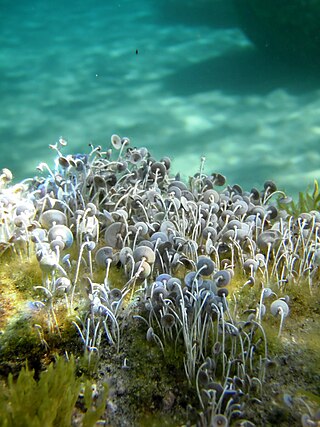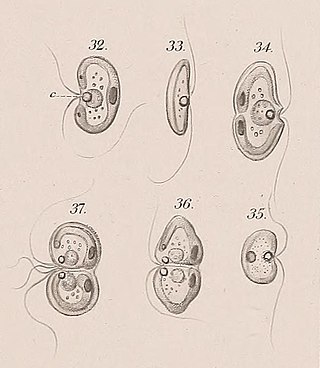
Acetabularia is a genus of green algae in the family Polyphysaceae. Typically found in subtropical waters, Acetabularia is a single-celled organism, but gigantic in size and complex in form, making it an excellent model organism for studying cell biology. In form, the mature Acetabularia resembles the round leaves of a nasturtium, is 4 to 10 centimetres tall and has three anatomical parts: a bottom rhizoid that resembles a set of short roots; a long stalk in the middle; and a top umbrella of branches that may fuse into a cap. Unlike other giant unicellular organisms, which are multinucleate, members of this genus possess a single nucleus located in the rhizoid, which allows the cell to regenerate completely if its cap is removed. The caps of two Acetabularia may also be exchanged, even from two different species. In addition, if a piece of the stem is removed, with no access to the nucleus in the rhizoid, this isolated stem piece will also grow a new cap.
Dichotomosiphon is a genus of green algae in the family Dichotomosiphonaceae. This genus is distinguished from all other members of the Bryopsidales by its oogamous reproduction and freshwater habitat. In both vegetative and reproductive aspects, it is remarkably similar to the genus Vaucheria, which is a member of the unrelated class Xanthophyceae.

Nephroselmis is a genus of green algae. It has been placed in the family Nephroselmidaceae, although a 2009 study suggests that it should be separated into its own class, Nephroselmidophyceae. One species can be an endosymbiont of Hatena arenicola.
Trichosarcina is a genus of green algae in the order Ulotrichales. Filoprotococcus was once regarded as a synonym. However, Filoprotococcus is now considered valid in its own right. Trichosarcina is considered to be of uncertain validity.

Karlodinium is a genus of athecate dinoflagellates that lives worldwide. They are often toxin producing, and compared to the other members of the Kareniaceae, are fairly small at <8-15 µm diameter. They are also able to form intense algal blooms. This species relies of photosynthesis and phagotrphy to grow.

Choristocarpaceae is a family in the order Discosporangiales of the brown algae. The family contains a single genus, Choristocarpus. The species is mostly located in the cold waters of the Northern hemisphere. A type of seaweed, Choristocarpaceae attaches itself to rocky substrate in places that are near continental shelves and the shore. Due to the species having morphological similarity, they were classified in closer relation with D. mesarthrocarpum. But due to many other differing characteristics Choristocarpaceae were put into their own family with a single genus and a single species of brown algae.

Pediastrum duplex is a species of fresh water green algae in the genus Pediastrum. It is the type species of the genus Pediastrum.
Aureococcus anophagefferens is a species of heterokont alga. Its cells have a single chloroplast, nucleus, and mitochondrion and an unusual exocellular polysaccharide-like layer. It causes harmful algal blooms. It is the only species in the genus Aureococcus.
Thalassiosira symmetrica is a species of marine centric diatoms. It differs with T. eccentrica in the value processes and distribution patterns. The latter species is more abundant in inshore waters, while T. symmetrica has been found in oceanic waters.
Gloeodinium viscum is a dinoflagellate symbiont of Millepora dichotoma.
Gambierdiscus pacificus is a species of toxic dinoflagellate. It is 67–77 μm long and 60–76 μm wide dorsoventrally and its surface is smooth. It is identified by a four-sided apical pore plate surrounded by 30 round pores. Its first plate occupies 20% of the width of the hypotheca.
Gambierdiscus australes is a species of toxic dinoflagellate. It is 76–93 μm long and 65–85 μm wide dorsoventrally and its surface is smooth. It is identified by a broad ellipsoid apical pore plate surrounded by 31 round pores. Its first plate occupies 30% of the width of the hypotheca.
Karlodinium antarcticum is a species of unarmored dinoflagellates from the genus Karlodinium. It was first isolated from the Australian region of the Southern Ocean, near the polar front. It is medium-sized and is characterized by its long ovoid cell shape and rather long apical groove. It is considered potentially ichthyotoxic.
Karlodinium ballantinum is a species of unarmored dinoflagellates from the genus Karlodinium. It was first isolated from the Australian region of the Southern Ocean. It is small-sized and is characterized by its very short apical groove. It is considered potentially ichthyotoxic.
Karlodinium corrugatum is a species of unarmored dinoflagellates from the genus Karlodinium. It was first isolated from the Australian region of the Southern Ocean, just south of the polar front. It is small-sized and is characterized by having distinctive striations on the epicone surface which are parallel, and a distinctively shaped and placed ventral pore. It is considered potentially ichthyotoxic.
Skeletonema marinoi is a diatom. Together with S. dohrnii, this species has flattened extremities of the processes of the fultoportulae, which interlock with those of succeeding valves without forming knuckles.

Batrachospermaceae is a family of fresh water red algae (Rhodophyta). Genera within the Batrachospermaceae generally have a "Lemanea-type" life history with carpospores germinating to produce chantransia. Sporophyte phase with meiosis occurs in an apical cell to produce the gametophyte stage. Pit connections have two pit plug cap layers with the other layer enlarged. This family of freshwater red algae is uniaxial, meaning each filament with a single apical cell. The genera included within Batrachospermaceae are listed in the table below.
Coolia is a marine dinoflagellate genus in the family Ostreopsidaceae. It was first described by Meunier in 1919. There are currently seven identified species distributed globally in tropical and temperate coastal waters. Coolia is a benthic or epiphytic type dinoflagellate: it can be found adhered to sediment or other organisms but it is not limited to these substrates. It can also be found in a freely motile form in the water column. The life cycle of Coolia involves an asexual stage where the cell divides by binary fission and a sexual stage where cysts are produced. Some of the species, for example, Coolia tropicalis and Coolia malayensis, produce toxins that can potentially cause shellfish poisoning in humans.

Timothy (Tim) John Entwisle, is an Australian botanist, much of whose research work is in phycology (algae). See for example the articles. He was awarded a Ph.D. from La Trobe University in 1986 for work on the taxonomy of Vaucheria.
Karlodinium armiger is a species of dinoflagellates belonging to the family Kareniaceae. It was first isolated from the Mediterranean sea & described in 2006.







